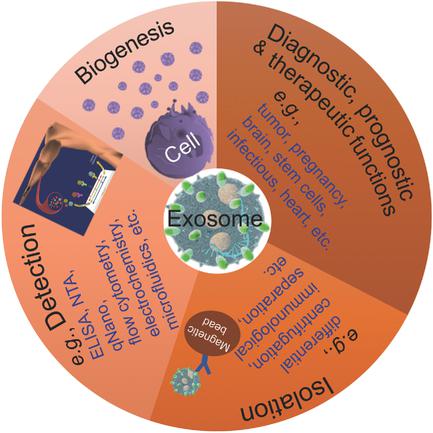Our official English website, www.x-mol.net, welcomes your
feedback! (Note: you will need to create a separate account there.)
Biological Functions and Current Advances in Isolation and Detection Strategies for Exosome Nanovesicles
Small ( IF 13.0 ) Pub Date : 2017-12-28 , DOI: 10.1002/smll.201702153 Kseniia Boriachek 1, 2 , Md. Nazmul Islam 1, 2 , Andreas Möller 3 , Carlos Salomon 4, 5 , Nam‐Trung Nguyen 2 , Md. Shahriar A. Hossain 6, 7 , Yusuke Yamauchi 6, 7 , Muhammad J. A. Shiddiky 1, 2
Small ( IF 13.0 ) Pub Date : 2017-12-28 , DOI: 10.1002/smll.201702153 Kseniia Boriachek 1, 2 , Md. Nazmul Islam 1, 2 , Andreas Möller 3 , Carlos Salomon 4, 5 , Nam‐Trung Nguyen 2 , Md. Shahriar A. Hossain 6, 7 , Yusuke Yamauchi 6, 7 , Muhammad J. A. Shiddiky 1, 2
Affiliation

|
Exosomes are nanoscale (≈30–150 nm) extracellular vesicles of endocytic origin that are shed by most types of cells and circulate in bodily fluids. Exosomes carry a specific composition of proteins, lipids, RNA, and DNA and can work as cargo to transfer this information to recipient cells. Recent studies on exosomes have shown that they play an important role in various biological processes, such as intercellular signaling, coagulation, inflammation, and cellular homeostasis. These functional roles are attributed to their ability to transfer RNA, proteins, enzymes, and lipids, thereby affecting the physiological and pathological conditions in various diseases, including cancer and neurodegenerative, infectious, and autoimmune diseases (e.g., cancer initiation, progression, and metastasis). Due to these unique characteristics, exosomes are considered promising biomarkers for the diagnosis and prognosis of various diseases via noninvasive or minimally invasive procedures. Over the last decade, a plethora of methodologies have been developed for analyzing disease‐specific exosomes using optical and nonoptical tools. Here, the major biological functions, significance, and potential role of exosomes as biomarkers and therapeutics are discussed. Furthermore, an overview of the most commonly used techniques for exosome analysis, highlighting the major technical challenges and limitations of existing techniques, is presented.
中文翻译:

外泌体纳米囊泡的生物学功能及其分离和检测策略的最新进展
外泌体是内吞起源的纳米级(约30–150 nm)细胞外囊泡,可被大多数类型的细胞脱落并在体液中循环。外泌体具有特定的蛋白质,脂质,RNA和DNA组成,可以作为货物将这些信息传递给受体细胞。对外泌体的最新研究表明,它们在各种生物学过程中发挥重要作用,例如细胞间信号传导,凝血,炎症和细胞稳态。这些功能性作用归因于它们转移RNA,蛋白质,酶和脂质的能力,从而影响各种疾病的生理和病理状况,包括癌症和神经退行性,传染性和自身免疫性疾病(例如,癌症的发生,发展和转移) )。由于这些独特的特征,外泌体被认为是通过无创或微创程序诊断和预后各种疾病的有前途的生物标志物。在过去的十年中,已经开发出了许多方法,可以使用光学和非光学工具来分析疾病特异性外泌体。在这里,讨论了外泌体作为生物标志物和治疗剂的主要生物学功能,重要性和潜在作用。此外,概述了最常用的外泌体分析技术,重点介绍了主要技术挑战和现有技术的局限性。已经开发了使用光学和非光学工具分析疾病特定外泌体的大量方法。在这里,讨论了外泌体作为生物标志物和治疗剂的主要生物学功能,重要性和潜在作用。此外,概述了最常用的外泌体分析技术,突出了主要技术挑战和现有技术的局限性。已经开发了使用光学和非光学工具分析疾病特定外泌体的大量方法。在这里,讨论了外泌体作为生物标志物和治疗剂的主要生物学功能,重要性和潜在作用。此外,概述了最常用的外泌体分析技术,重点介绍了主要技术挑战和现有技术的局限性。
更新日期:2017-12-28
中文翻译:

外泌体纳米囊泡的生物学功能及其分离和检测策略的最新进展
外泌体是内吞起源的纳米级(约30–150 nm)细胞外囊泡,可被大多数类型的细胞脱落并在体液中循环。外泌体具有特定的蛋白质,脂质,RNA和DNA组成,可以作为货物将这些信息传递给受体细胞。对外泌体的最新研究表明,它们在各种生物学过程中发挥重要作用,例如细胞间信号传导,凝血,炎症和细胞稳态。这些功能性作用归因于它们转移RNA,蛋白质,酶和脂质的能力,从而影响各种疾病的生理和病理状况,包括癌症和神经退行性,传染性和自身免疫性疾病(例如,癌症的发生,发展和转移) )。由于这些独特的特征,外泌体被认为是通过无创或微创程序诊断和预后各种疾病的有前途的生物标志物。在过去的十年中,已经开发出了许多方法,可以使用光学和非光学工具来分析疾病特异性外泌体。在这里,讨论了外泌体作为生物标志物和治疗剂的主要生物学功能,重要性和潜在作用。此外,概述了最常用的外泌体分析技术,重点介绍了主要技术挑战和现有技术的局限性。已经开发了使用光学和非光学工具分析疾病特定外泌体的大量方法。在这里,讨论了外泌体作为生物标志物和治疗剂的主要生物学功能,重要性和潜在作用。此外,概述了最常用的外泌体分析技术,突出了主要技术挑战和现有技术的局限性。已经开发了使用光学和非光学工具分析疾病特定外泌体的大量方法。在这里,讨论了外泌体作为生物标志物和治疗剂的主要生物学功能,重要性和潜在作用。此外,概述了最常用的外泌体分析技术,重点介绍了主要技术挑战和现有技术的局限性。











































 京公网安备 11010802027423号
京公网安备 11010802027423号